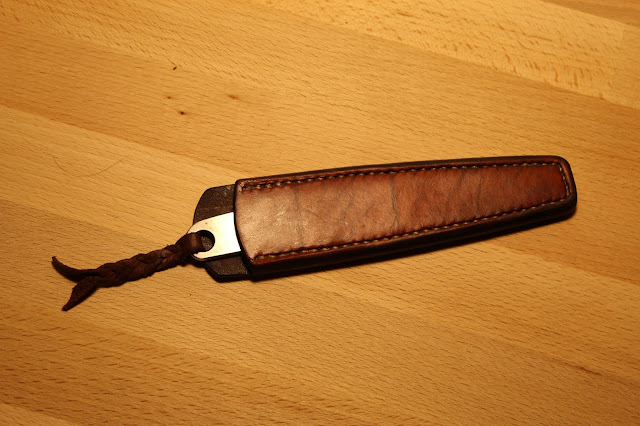Happy holidays everyone!
Just thought I'd document some work that I'm doing for a customer I've been in contact with over the holiday break. The request was to make a leather sheath and leather handle guard for a Hultafors classic axe. I've made a number of axe sheaths in the past, but a leather handle guard would be a first for me and a fun challenge.
There are a number of different ways a leather guard can be attached, using either paracord and eyelets to fasten it temporarily or with skein to permanently attach it to the handle, and a number of stitching methods such as cross stitch and whip stitch. I opted to go the permanent route and chose to use a baseball stitch to minimize the amount of exposed thread for durability.
Normally when leather working I would attempt to make a template to minimize the amount of leather wasted , but in this case it was more trouble than it was worth to try to wrap a piece of paper around the handle to get an idea of how much leather was needed. I dyed the leather with gel antique and clamped the leather down around the handle in a vise to get an idea of how much excess there would be, followed by alot checking and trimming to get the final shape.
The final form was then dipped in wax to give it rigidity and waterproofing, then punched out for lacing with artificial sinew. One important learned while working with artificial sinew on oddly shaped pieces - get appropriately shaped needles and ones with an appropriate sized eye or you're going to need to buy more needles haha.
The process of executing a baseball stitch is well documented in tutorials for upholstery - but below are a few pics of how I went about it. Nothing too fancy, it's like doing two whip stitches that cross one another - just make sure you tighten everything up as you go along.


Something I probably should have documented was how to finish the stitch, but I'll the best I can to explain it and that it shows in the final picture. After reaching the last holes, double back to the second last holes, then tighten up the final loops at the end of your piece and tie the two threads together ( I used the beginning of a snake knot) as close as you can to the leather. Use a curved needle to pull the loose ends under your existing stitches to pull both the knot and the loose ends underneath ( about 4-5 stitches should be good), then carefully trim the excess. The result should be a clean final stitch where the loose ends are essentially invisible, and more importantly - protected from fraying or loosening.
At the end of the day, the final product should be snugly to the handle with the stitches and if tightened sufficiently, slightly sunken into the leather. For extra measure I added a coating of my home made leather finish covered in my other posts, and gave the stitches a pass with a lighter to remove any frays or stray strands. All in all I think this was a successful attempt, although personally I think the stitching can be more even with practice. All that said , I'm confident that it'll serve the customer well and give the axe a classy appearance to match with the leather sheath that I will be covering shortly. Stay tuned!










































































